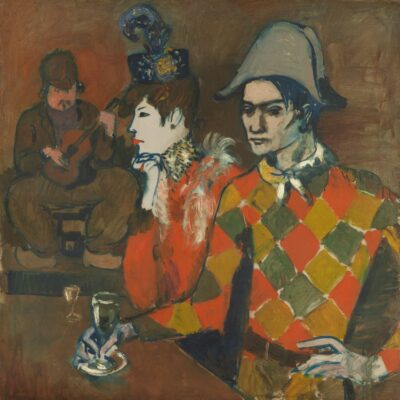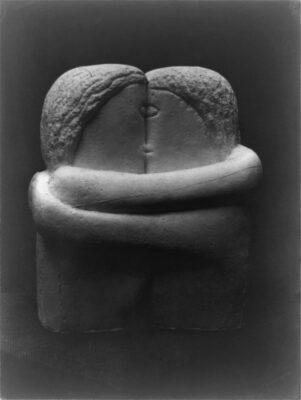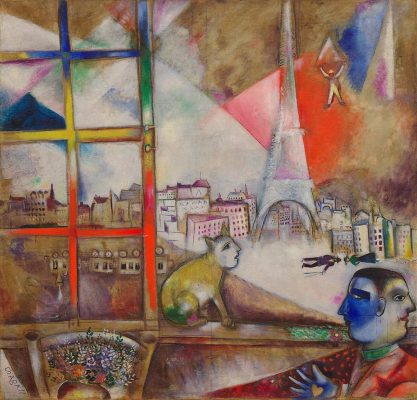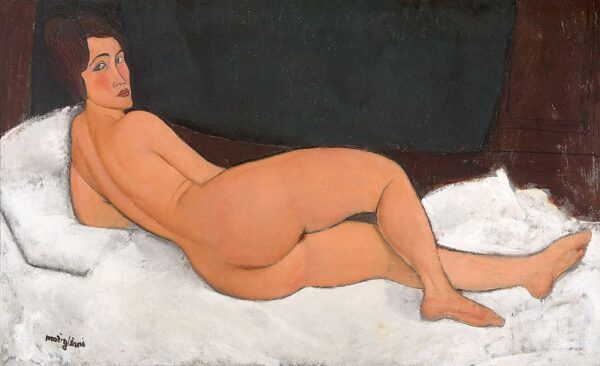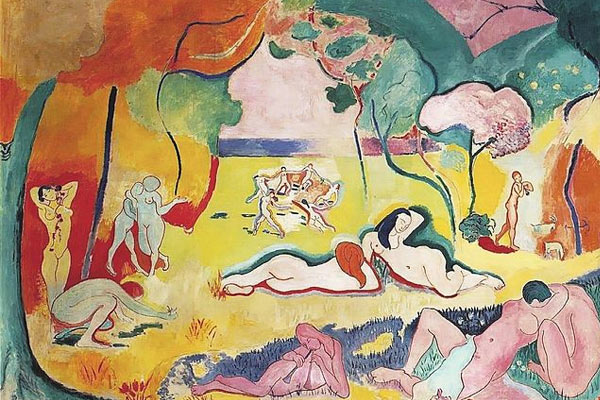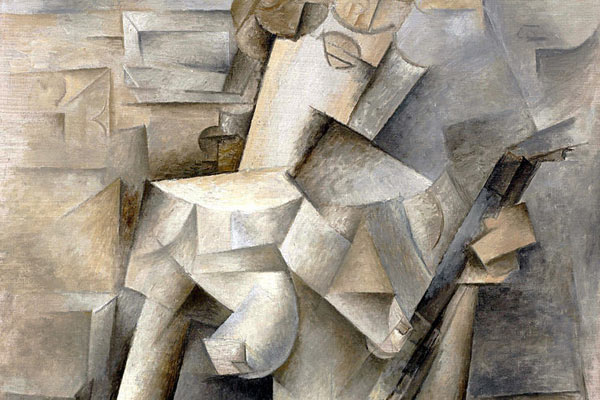School of Paris
Étrangers among easels and absinthe
La bohème, la bohème
Charles Aznavour, “La Bohème”
Ça voulait dire
On a vingt ans
La bohème, la bohème
Et nous vivions de l’air du temps
Pablo Picasso: “Au Lapin Agile”, 1905. Oil on canvas, Metropolitan Museum ·· Constantin Brâncuși: “The Kiss”, 1907-08. Plaster cast, 27,9 × 26 × 21,6 cm.
At the height of the Belle Époque, Paris was the artistic capital of the world. It was so not only at the exclusive and elitist level of the official Salons, but during the last years of the 19th century, the growing recognition of the Impressionist painters had shown that, despite initial misgivings, there was room in Paris for young artists with new ideas, who would find there a propitious environment in which to grow and evolve. This, together with the improvements in railway communications, led many young artists from other European countries to settle in Paris at the beginning of the 20th century, encouraged by the lively and daring atmosphere of the French capital. This group of artists of different nationalities and very varied styles became known by the somewhat confusing name of the School of Paris. As with the term “Post-Impressionism”, it does not refer to a specific movement or style, but to a heterodox group of individuals, many of them involved in the birth of several of the most important avant-garde movements of the first half of the 20th century, such as Cubism or Surrealism.
These young artists (among whom there were also, of course, French artists) resided mainly in two neighbourhoods of the then Parisian periphery: Montmartre and Montparnasse. In the former, which had been the heart of Parisian bohemian life already in the second half of the 19th century, the epicentre of artistic creation was a building known as Bateau Lavoir, while nightlife took place in the cafés and cabarets, especially the small “Lapin Agile“. After the First World War, most artists moved to Montparnasse, a newly created, more cosmopolitan district, where there was “an atmosphere of effervescent emulation in which extreme freedom rubbed shoulders with extreme misery, confronted, sometimes confused, with the gaudy luxury ostentations of the new post-war rich” (Raymond Cogniat: “The School of Paris”, 1984).
The cafés and cabarets of Montmartre were frequented by the young Pablo Picasso (1881-1973), who first travelled to Paris at the age of eighteen, settling permanently in the French capital four years later. In Paris, Picasso went through his somber and melancholic Blue Period (1901-1904) and his Rose Period (1904-1906), marked by his fascination with the circus life of acrobats and harlequins, before changing the history of art with “Les Demoiselles d’Avignon” (1907), the proto-Cubist masterpiece inspired both by African art that Picasso had occasion to see in Paris and by Henri Matisse’s “Le bonheur de vivre” (1906). “Les Demoiselles” opened the door to Cubism and, with it, to the break with the Cartesian space adopted since the Renaissance, a chapter that will be discussed in a separate entry.
Marc Chagall: “Paris through the window”, 1913. Oil on canvas. Guggenheim Museum, Nueva York ·· Amedeo Modigliani: “Nu couché (sur le côté gauche)”, 1917. Oil on canvas. Private collection
Romanian sculptor Constantin Brâncuși (1876-1957) arrived in Paris the same year as Picasso. After studying for a short period of time with Auguste Rodin, he soon began to develop his own avant-garde style of sculpture, in which we can find parallels with the fauvists: just as those emphasized the intrinsic value of painting and its appreciable qualities beyond the representational value (color, brushstroke), in Brâncuși’s sculptures “volume, mass, texture, have ceased to be instruments for a better traditional representation of the narrative anecdote, they are now (…) components that have in themselves semantic value” (Valeriano Bozal: “The origins of 20th century art”, 1993).
At the Bateau Lavoir, Picasso met the Italian Amedeo Modigliani (1884-1920), who, after a brief return to Italy, settled in Montparnasse in 1909, where he befriended Brâncuși. The influence of the latter and of African art were vital for Modigliani to succeed in creating his definitive style, based on a remarkable stylization of faces, both painted or sculpted, appreciable in his portraits and in his famous female nudes. “Modi”, as he was called by his friends, was the epitome of the bohemian artist of early 20th-century Paris: a drinker, a womaniser, and ignored by critics. He died young, aged just 35, a victim of tuberculosis, and his fiancée –Jeanne Hébuterne, who was eight months pregnant at the time- committed suicide shortly afterwards.
The Russian painter Marc Chagall (1887-1985) arrived in Paris without knowing how to speak a single word of French. In Paris, Chagall united Jewish folklore and European avant-garde in a unique style, part Fauvist, part Cubist, and full of a fantasy that seems to anticipate Surrealism. Other notable artists were Chaïm Soutine (1893-1943), born in present-day Belarus and a personal friend of Mogiliani; the Bulgarian Jules Pascin (1885-1930), known as “the Prince of Montparnasse”; and the Japanese -later naturalized French- Tsuguharu Foujita (1886-1968).
G. Fernández · theartwolf.com
Follow us on:

